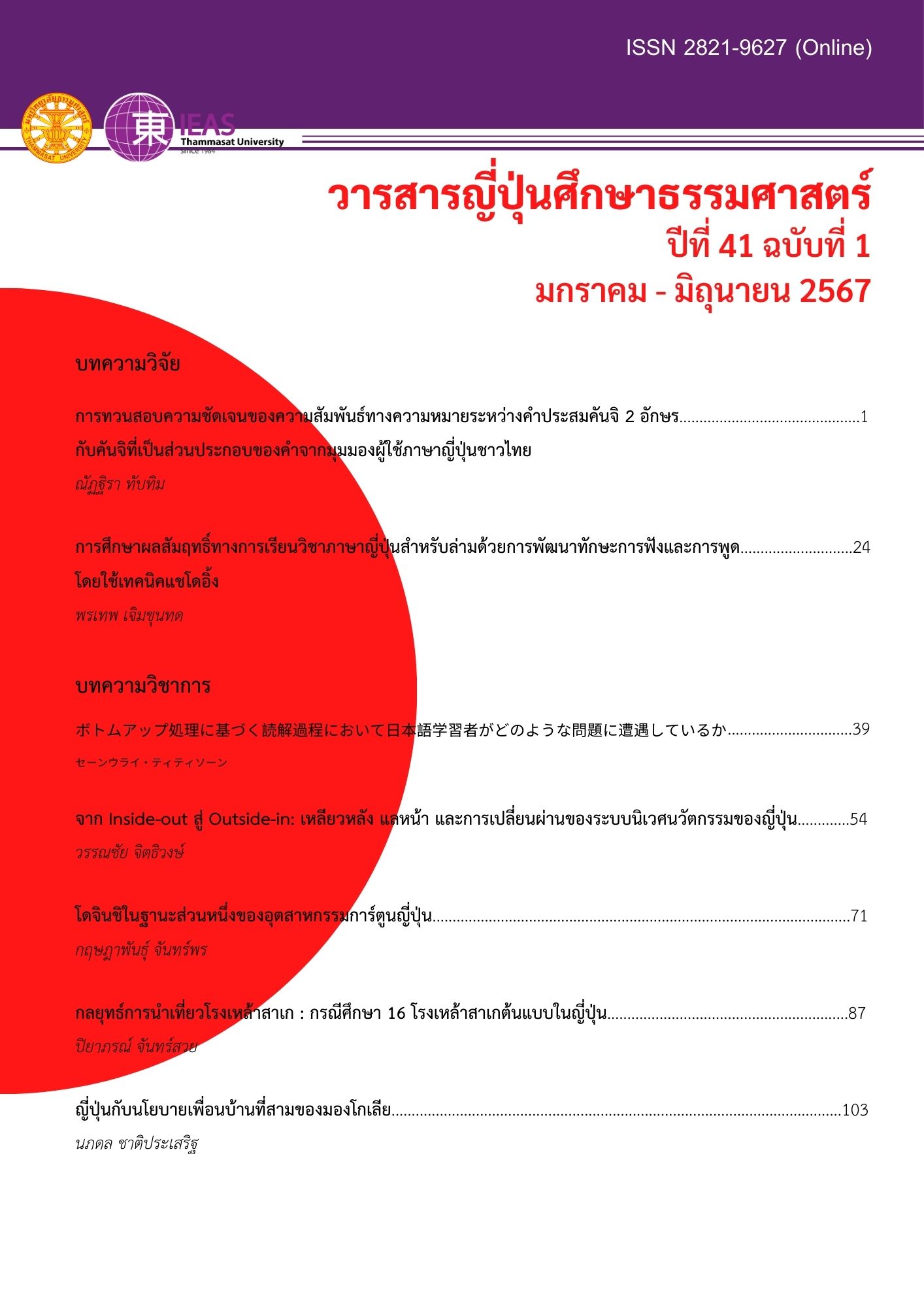The reconfirmation of semantic transparency between two-Kanji compound words and the composing Kanji from the viewpoint of Thai Japanese speakers
Keywords:
Reconfirmation, Semantic transparency, Two-Kanji compound words, Composing Kanji, Viewpoint of Thai Japanese SpeakersAbstract
This research aimed to 1) investigate the opinions of Thai Japanese speakers regarding the semantic transparency between two-Kanji compound words and the composing Kanji that constitute 415 words and 2) study the relationship between the opinions of Native and Thai Japanese speakers regarding the semantic transparency of the two-Kanji compound words and the composing Kanji of 415 words. The sample group consisted of 12 Thai Japanese speakers who achieved N2 or N1 proficiency level of the Japanese language proficiency test. The Pearson Product Moment Coefficient was applied as a simple correlation coefficient to analyze
the relationship between two sets of data. The results of the study found both consistency and inconsistency from opinions of Thai Japanese speakers regarding the semantic transparency. The findings indicated a consistent direction of correlation and a statistically significant moderate correlation (p-value < .01) between the opinions of Native and Thai Japanese speakers concerning the semantic transparency between two-Kanji compound words and the composing Kanji.
Downloads
References
ชนัญญ์ธร รุ่งธัญนิธิธรณ์. (2555). การศึกษากลวิธีการเรียนคันจิของนักเรียนชั้นมัธยมศึกษาตอนปลาย. วารสารญี่ปุ่นศึกษา, 28(2), 58-69.
บุษบา บรรจงมณี. (2561). ความคิดเห็นต่อกลยุทธ์การเรียนคันจิของผู้เรียนภาษาญี่ปุ่นชาวไทย: เปรียบเทียบความแตกต่างระหว่างความคิดเห็นของผู้สอนและผู้เรียน. วารสารเครือข่ายญี่ปุ่นศึกษา, 8(2), 77-94.
ประคอง กรรณสูต. (2542). สถิติเพื่อการวิจัยทางพฤติกรรมศาสตร์ (พิมพ์ครั้งที่ 3). โรงพิมพ์แห่งจุฬาลงกรณ์มหาวิทยาลัย.
ปาจรีย์ วิวัฒนปฐพี. (2560). การศึกษาการใช้แผนผังเชื่อมโยงคันจิในการเรียนการสอนคันจิ สำหรับผู้เรียนชาวไทยในระดับกลางตอนต้น. วารสารเครือข่ายญี่ปุ่นศึกษา, 7(1), 51-65.
สำนักงานปลัดกระทรวงการอุดมศึกษา วิทยาศาสตร์ วิจัย และนวัตกรรม. (n.d.). ระบบพิจารณาความสอดคล้องของหลักสูตรระดับอุดมศึกษา (CHE Curriculum Online: CHECO). http://checo.mhesi.go.th/
Best, J. W. (1977). Research in Education (3rd ed). Prentice – Hall Inc.
Chaiyakhettanang, S. (2008).「タイ国内における初級タイ人学習者の漢字意識」『日本語教育国際シンポジウム「東南アジアにおける日本語教育の展望」』, 49-53.
ヴィモンヴィタヤーチョーラッダー. (2014). 「タイ人初級日本語学習者の漢字学習に関する事例研究一漢字の自由記述課 題の結果から一」『JSL漢字学習研究会 誌』(6), 36-43.
海保博之・ハットトワ・ガヤトゥリ. (2001).「非漢字圏日本語学習者に対する効果的な漢字学習についての認知心理学からの提言」「筑波大学心理学研究』(23), 53-57.
川上正浩. (2018). 「漢字二字熟語の意味とそれを構成する漢字の意味との関連性(透明性)データベースの構築」『大阪樟蔭女子大学研究紀要』8, 19-28.
栗原由加. (2019).「日本語学習者の漢字習得プロセスについて考える―タイの非漢字系学習者へのアンケート調査を通じて―」『神戸学院大学グローバル・コミュニケーション学会紀要』4, 17-28.
桑原陽子. (2009).「漢字未知語の意味推測に及ぼす語構成の影響―中上級非漢字系日本語学習者のケーススタディより―」『福 井大学留学生センター紀 要』(4), 21-30.
桑原陽子. (2012).「漢字2字熟語の意味推測に及ぼす語構成に関する知識の影響 : 主要部の位置との関わりから」『福 井大学留学生センター紀 要』(7), 1-10.
桑原陽子. (2013).「漢字2字熟語の意味の透明性の調査」『福 井大学留学生センター紀 要』(8), 1-13.
佐々木良造・尾沼玄也・上野亮一. (2008). 「タイ人日本語学習者の作文にみられた漢字の書き誤り-書き誤り率と学習期間及び漢字テストの成績の関係を中心に-」『日本語教育国際シンポジウム「東南アジアにおける日本語教育の展望」』, 39-43.
本多由美子. (2017).「二字漢語における語の透明性―コーパスを用いた語と構成漢字の分析―」『軽量国語学』31(1), 1-19.
文部科学省. (2017). 『小学校学習指導要領(平成29年告示)解説 国語編』https://www.mext.go.jp/a_menu/shotou/new-cs/1387014.htm
Downloads
Published
Issue
Section
License
Copyright (c) 2024 Thammasat Journal of Japanese Studies

This work is licensed under a Creative Commons Attribution-NonCommercial-NoDerivatives 4.0 International License.




